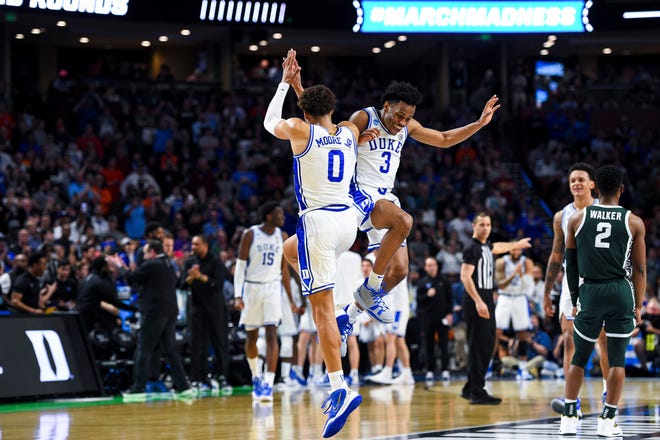
This past weekend, I watched the first two rounds of the annual NCAA March Madness tournament. It is one of the coolest times of the year. The games, pace, and non stop action create for one of the most enjoyable fan experiences throughout the sports calendar year.
That is – if your national champion makes it to round three (sorry Kentucky faithful).
One of the most exciting games from the weekend happened between #7 Michigan State and #2 Duke. From a coaching perspective, it was a legendary match up. Michigan State’s Tom Izzo – one of college basketball’s finest coaches in March – had one last chance to dethrone Duke’s Mike Krzyzewski – 5X NCAA Champion and winningest NCAA coach. At conclusion of this season, Coach K will call it a career – and what a career it was.
Duke – a 6.5 point favorite – jumped out to an early lead courtesy of Paolo Banchero – projected top-5 NBA Draft pick. They held this margin until late in the second half, when Michigan State made a run and retook the lead 74-72 with 2:50 remaining. Two possessions later, Banchero responded – nailing a jump shot that gave Duke the lead for good. They finished the game on a 10-2 run winning by a score of 85-76.
As I looked back through the box score, I noticed something pretty interesting. For as close of a game as it was, the game stats seemed to suggest otherwise. From a field goal standpoint, Duke outshot Michigan State 57.1% (32-56) to 41.5% (27-65). They went to the free throw line nine more times, scoring five more points. Five of Duke’s eight players recorded double digit scoring figures. Only three from Michigan State did the same.
I didn’t understand why the game was so close until I looked at the three point column. Over the course of the contest, Duke converted on 5 of its 13 three point shot attempts for a 38.5% success rate. Michigan State launched 22 three point shots – nine more than Coach K’s club – converting half. Of their 76 points, 43% came courtesy of the three point shot. They might have only shoot 41.5% from the floor, but their performance was far from inefficient. It’s the perfect way to illustrate basketball’s changing landscape.
Which, in a lot of ways, was fueled by baseball.
Bill James and Billy Beane’s data driven influence on baseball has extended far beyond the baseball field. Analytics have played a huge role in the brand of basketball played today. Contested mid range jumpers – largely inefficient scoring opportunities – have been replaced by layups, dunks, catch and shoot threes, and free throws – much more efficient scoring opportunities. Instead of settling for jump shots in the 15-18 foot range, teams have learned how to create those same shots behind the three point arc. Teams are less stubborn about grinding for points in the paint and more interested in space and pace. Gone are true forwards. “Stretch fours” have become more a necessity than commodity. “Five men out” is no longer an offense for teams who lack size. It’s an offense designed to create more opportunities at the rim and beyond the arc.
For historical perspective, Coach K and Izzo first met in the NCAA Tournament back in 1994. Izzo was an assistant at the time. Duke beat Michigan State by a final score of 84-75. Only five three point field goals were made throughout the course of the entire game. The leading three point field goal scorer in 1994 – Chris Brown of UC Irvine – sunk 122 shots from behind the arc. The leader from this past season – Darius McGhee of Liberty – sunk 142. Nine different players this year attempted over 285 three point field goals – roughly 7 per contest in a 40 game season. Only three surpassed that mark in 1994.
This change in shot selection has had a significant impact on offensive production. If we look at the 1994 NBA Finals, the Houston Rockets defeated the New York Knicks four games to three. Over the course of seven games, Houston averaged 86.1 points per contest. Their highest point total came in game three when they scored 93 to take a 2-1 series advantage. Last summer, the Milwaukee Bucks defeated the Phoenix Suns in six games to win the 2021 NBA Finals – their first world championship since 1971. They averaged 111.7 points per contest, scoring 120 points in two different games. The only game in which one team did not score at least 100 points was game six. Phoenix scored 98.
Despite the recent surge in offensive production, analytics in hoops has been met with opposition. Fans have grown weary of selling out for threes and dunks. Data “nerds” have become scapegoats for the declining shot selection in the mid range area of the court. Why put your trust into people who have never played the game? Numbers and nerds don’t win games. Players do.
Ahh, sound familiar baseball fans?
…
I’ve recently been going through The Midrange Theory by Seth Partnow, former Director of Basketball Research for the Milwaukee Bucks. In the opening chapters, Partnow said the following when referencing the influence analytics has had on basketball:
“Analytics at its heart is about asking the right questions.”
I mean, how spot on is that?
Seeing basketball’s struggle with analytics has been refreshing, to a degree. It’s a nice reminder that analytics aren’t just bastardized in baseball. They’re bastardized in every sport. It seems like these days fans and announcers are blaming nerds for failed fourth down conversations, bad shot attempts, and other situations which data could have influenced a specific decision. It’s the epitome of outcome bias. We’re not evaluating the systems behind a certain decision. We’re evaluating the decision based on how it turned out. Analytics has simply become the scapegoat for when it doesn’t work out.
This is why I love Partnow’s quote. Analytics doesn’t guarantee success. Luck, chance, and randomness play a role in sports that make deterministic predictions unrealistic. We have to instead learn how to play the percentages. The odds will never be completely in our favor, but that doesn’t mean we shouldn’t always look for an edge. Analytics are the new avenue to help exploit that edge.
When we look at the numbers on the hard court, they paint a pretty clear picture: The most inefficient shot in basketball is the one that could have earned one more point if you took two steps back. It doesn’t mean teams don’t take mid range shots. Just watch DeMar DeRozan of the Chicago Bulls play. They’re just much more careful about who takes them and when. If the goal is to score more points, the goal of analytics is to figure out how. Basketball is always going to be basketball, but how we optimize for success is always evolving. The recent surge in threes isn’t for theatrics. It’s to maximize offensive output – as seen with Michigan State’s aerial surge this past weekend.
We’ve seen the same exact thing in baseball. More teams are utilizing the power of the long ball to optimize for offensive production. Gone are the days where 2-3 of your nine have game changing pop. These days, 1-9 have the ability to do it. While it’s created for some exciting offensive action, it’s also generated backlash. Fans have grown tiresome of outcomes that don’t involve a batted ball in play. “Launch angle swings” have become the scapegoat for the increase in punch outs league wide. If we call it for what it is, it’s reductionism: We’re taking something we don’t understand well (why strikeouts are increasing) and applying it to things we think we understand well (stupid nerds – they’ve never played the game). The same thing is happening in basketball. This friction isn’t the fault of numbers. It’s the fault of people who don’t understand the numbers – or at least could care less about the story they’re trying to tell.
It’s at least nice to see baseball isn’t the only sport that struggles with this.
…
The next competitive advantage in sports is not going to be data.
Everyone has it. Everyone is using it – but not everyone is using it the same way. The competitive advantage of the future is not going to be in collection, but implementation. It’s the coaches who understand how to leverage both the “old school” and “new school” theories of thought. It’s the men and women who can read, interpret, and clearly communicate information that has performance changing implications. Players don’t need to understand advanced stats or the function of specific algorithms. They need the confidence to go out and do what they know how to do best. Data doesn’t create confidence. Coaches do. When you learn how to leverage data to your advantage, however, your opportunities for influence are limitless.
Don’t run away from data because you don’t understand it. Analytics are here to stay. Their influence on sports is only going to increase, which makes the role of a good coach increasingly more important. The three point shot is not going away in basketball, and neither is the home run in baseball. That advantage has come and gone. The next advantage is waiting to be discovered.
… Or has it been already?
